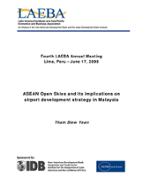ASEAN Open Skies and Its Implications on Airport Development Strategy in Malaysia
Date
Jun 2008
This paper seeks to examine the implication of open skies in ASEAN on the airport development strategy in Malaysia. "Open Skies," in general, refers to the liberalization of aviation markets that can be pursued on a bilateral, regional, or multilateral basis. The findings show that although Malaysia has invested substantially in overall infrastructure development, including airports, other member countries within ASEAN, notably Singapore and Thailand, have also followed a similar investment-intensive strategy to develop their international airports into airport hubs. The dream to turn Kuala Lumpur International Airport (KLIA) into a regional hub requires Malaysia to undertake several measures to overcome the competitive pressures from neighboring hubs. This includes joining a strategic global alliance group to improve the traffic feed of the national carrier. It will also require the government to accelerate the construction of the new Low Cost Carrier Terminal (LCCT) at KLIA. The strategy to build a cargo hub at Senai should be reviewed while the promotion of tourism, especially to non-ASEAN countries has to focus on a distinctive product appeal that will enable the country to differentiate its tourism products from those of regional competitors. This paper was prepared for the Latin America/Caribbean and Asia/Pacific Economics and Business Association (LAEBA)'s 4th Annual Meeting held in Lima, Peru, on June 17th. 2008.



